The Great Galactic Alignment of 2012
Some who claim that the Maya predicted the end of the world in 2012 use a particular astronomical alignment that is believed will occur at the end of the 13th Bak'tun in the Maya Long Count calendar (December 21st, 2012) as evidence to support their notions. The claim is that on that date the Sun will align with the center of the Milky Way Galaxy, which only happens once every 25,772 years. They claim that the Maya knew about this alignment and set their Long Count calendar to end on this day because the alignment will cause something to happen. Just what this something is seems to depend only on the imagination. You can visit Wikipedia for more about such claims and the people making them. Note that the claims are not being made by Maya people themselves.
Let’s examine the facts to see if this claim of an alignment is true.
The Galactic Context
The Sun is but one of a few hundred billion stars that make up the Milky Way Galaxy. The Milky Way Galaxy is shaped like a disk with a bulge in the center. The disk is about 100,000 light-years across and 1,000 light-years thick. Remember, a light-year is the distance that light travels in one year (it is not a measurement of time, but of distance). A good scale model for the Galaxy would be a CD/DVD/Blu-ray disc with a marble in the center.
The Sun is located about 30,000 light-years from the center (about halfway out). The Sun moves in a roughly circular orbit about the center of the Galaxy (the fine details of the orbit are pretty messy), taking about 250 million years to complete one trip.
Since we are located inside the disk of the Milky Way, we do not have that outsider view of it. Here on Earth, we see it as a band of hazy light running through the sky with dark rifts inside it. From this perspective and using only the unaided eye, it is difficult to discern its center. But with modern tools like telescopes that can see infrared and radio light, we now know that the center is located in the constellation of Sagittarius (which is most prominent in the summertime sky in the Northern hemisphere).
At the center of the Milky Way Galaxy lies a black hole with the mass of millions of Suns. We’ve found that most, if not all, big galaxies in the Universe contain these monstrous black holes in their centers.
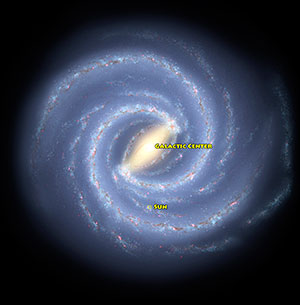
An artist’s concept of the Milky Way Galaxy seen from above. This map uses the latest knowledge of the structure of the Galaxy and the Sun’s location.

A CD with a marble in its center is a good model for the structure of the Milky Way Galaxy. Note that this model is stuck to a stand and viewed at two different angles: mostly face-on (top) and edge-on (bottom).
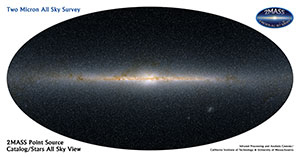
An image of the entire sky projected like a map shows the Milky Way Galaxy’s appearance from our perspective within the disk. This image was constructed from infrared data collected by the 2MASS project. Infrared light passes through much of the dust in the Galaxy allowing us to see more of its structure than we can with our eyes.
Alignment With the Galactic Center
When people talk about alignments we need to be clear. The Sun and the center of the Galaxy are only two points: they always form a line! So an alignment in space of the Sun with the Galaxy is meaningless. Throwing Earth into the mix changes the situation. In this case, an alignment of all three objects is probably something rarer, right? Indeed!
It won’t be happening in 2012. In fact, an alignment of Earth, the Sun, and the Galactic center will not happen for over 4 million years! In our current position in the Galaxy, the Sun never appears to align exactly with the Galactic center, from Earth’s perspective. The closest the Sun appears to be next to the Galactic center is about 6.4 degrees (nearly 13 times the width of the full moon). That’s not much of an alignment. It will take well over 4 million years for the Solar System to move around the Galaxy enough to allow us to see the Sun projected directly in front of the Galactic center.
From our perspective on Earth, the Sun does appear to pass in front of the band of the Milky Way twice per year (currently once in December and once in June). It has done this every year since the beginning of the Solar System, 5 billion years ago. So there is nothing special at all about this kind of alignment.
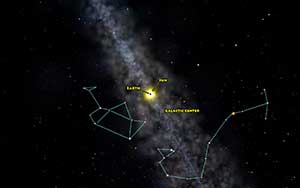
From a perspective in space, we can see that the Earth and the Sun do not align with the center of the Milky Way Galaxy on December 21st, 2012. This perspective is from within the plane of the Solar System looking from behind Earth toward the Sun and toward the center of the Galaxy.
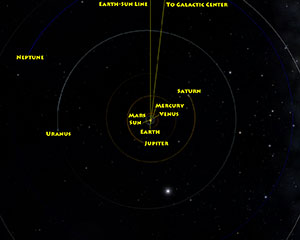
From a perspective in space, we can see that the Earth and the Sun do not align with the center of the Milky Way Galaxy on December 21st, 2012. This perspective is from above the plane of the Solar System and we can see the two different lines of sight from Earth to the Sun and from Earth to the Galactic center. Also note that there is no alignment of planets on this date, which some 2012 doomsday theorists claim.
Solstice Alignment
On December 21st, 2012, the Sun will be aligned with the middle of the Milky Way band, from our perspective on Earth (though it is not aligned with the Galactic center). In this part of the Milky Way, there are several dark rifts and the Sun appears in one of them.
The date of this “alignment,” December 21st, is the Winter Solstice (the shortest day/longest night of the year) in the northern hemisphere. However, when the Maya created the Long Count calendar over 2,000 years ago, the Sun would not have been seen in this location in the Milky Way on the Winter Solstice. The date of any annual alignment of the Sun with the stars (including the Galaxy) changes by one day every 72 years due to a wobble in Earth’s rotation called precession. The exact alignment of the Sun with any spot in the heavens on a specific date therefore only occurs every 25,772 years.
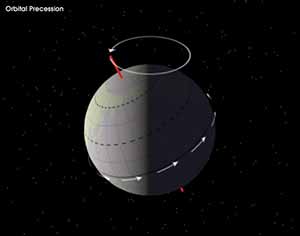
A snapshot from a NASA animation that demonstrates the concept of precession of Earth’s axis of rotation, which is the cause of the precession of dates of solar alignments with celestial objects.
There is evidence that has convinced several scholars to think that the classical Maya knew about this precessional drift in time of solar-stellar alignments. Indeed, the evidence indicates that the ancient Maya may have synchronized several of their calendars to alignments of important constellations with the Sun. They may have calculated the locations of these constellations into prehistory to make these alignments coincide with mythological events. If they were able to run the precessional clock backwards, they could just as easily run it forward. Such astronomical observations were well within their observational capabilities. For example, let’s say the ancient Maya noted the date that the Sun appeared in the middle of the dark rift in the Milky Way located in the constellation Sagittarius. After 72 years they would note that the alignment was happening one day later. After 144 years, the date would now be 2 days later than the first observation. After several generations they would have enough data to be sure that the precession was real (not a mistake in counting days) and be able to accurately account for it. This leads us to wonder if the ancient Maya set their Long Count calendar to reach the end of the 13th Bak’tun when the Sun was seen in one of the dark rifts in the Milky Way during the Winter Solstice.
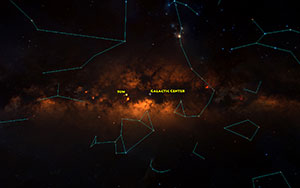
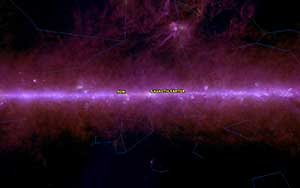
A view of the sky seen in visible light from the Digitized Sky Survey (top) and in infrared light from NASA’s Infrared Astronomical Satellite, or IRAS, mission (bottom). The Sun’s position on December 21st, 2012 is plotted in each. This cannot be directly observed on this date since the Sun’s brightness lights up the sky making it much brighter than the stars.
These rifts are actually made up of enormous clouds of dust and gas where new stars are forming. There are so many of these clouds between us and the stars of the Galaxy behind them, that the light from those distant stars is blocked out. So we see the shapes of these clouds in silhouette. We can see the clouds themselves in infrared light. NASA missions like IRAS, Spitzer, and WISE have mapped out the plane of the Milky Way to understand the roles these clouds play in the life cycle of the Galaxy.
The Sun does appear to cross through a rift on December 21st, 2012. But it began crossing through the rift on the Winter Solstice date back in about the year 1800 AD. The rift does not have exact boundaries since it is made of clouds of dust and gas. The Sun will continue to be viewed against the backdrop of this rift during the Winter Solstice until at least the year 2100.
If the ancient Maya were aware of precession, they would have known that the Sun would be viewed within this rift during the Winter Solstice for about 400 years. So what importance would they have given such an alignment, what would they have thought that it meant? This is an open question for Maya researchers. We know that their understanding of the sky was intimately tied to their mythology and religion. Scholars are trying to understand and decipher that mythology as best as they can, through the study of the empirical evidence.
But What If?
What if there was an exact alignment of the Sun with center of the Galaxy, as seen from Earth? Would there be any physical effects on us?
Well, the central part of the Galaxy has the mass and luminosity of tens of billions of suns. But it is 30,000 light-years away. Because of that great distance, the strength of its gravity on Earth is several hundred million times weaker than the strength of the Sun’s gravity. Plus, the Sun is hundreds of millions of times brighter in the sky than the Milky Way, also because of the huge difference in distance. So the answer is a resounding “no.” It makes no difference if the Sun is aligned or not, the effects of the center of the Milky Way Galaxy on Earth are utterly insignificant any day of the year. People often worry about the effects of gravitational tides when there is talk of an astronomical alignment. Tides are a shearing/stretching aspect of gravity and are much weaker than regular gravitational forces. So if the gravity of the Milky Way is totally insignificant compared to that of the Sun, or even the Moon, then the tidal forces will be all the more insignificant.
Even if the very talented ancient Maya astronomers and priests meant for the 13th Bak’tun anniversary to occur with the alignment of the Sun in a dark rift of the Milky Way on the Winter Solstice, it isn’t a rare alignment. So nothing physical could be expected to happen in 2012 that wouldn’t have been occurring already for hundreds and even billions of years.
It looks like the “great Galactic alignment” of 2012 is much ado about nothing.
11380